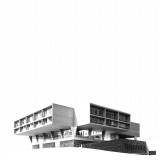The research titled "Demolition VS Creative Reuse", by Stefania Ketsi and supervising Professor Mrs. Evelyn Gavrilou explores the theoretical principles and criteria required to judge buildings to be preserved and suitable for utilization and reuse. The reason for conducting the research was the publications that report on the demolition of large-scale buildings, modern architecture of the 20th century and mainly represent the brutalist architecture. The study was based on archival material of books, articles and publications of electronic sources, which helped to create a complete picture of the phenomenon. Also, for a better understanding of the objectives, definitions and concepts related to the field of reuse are listed. The search for the sources results in a comparison of the various practices, which have been applied on a large scale. In addition, through the historical background, it is possible to make a more extensive analysis of Brutalism, a movement that provoked many positive and negative reactions, but in recent years seems to have lost its glamor with the risk of destroying representative species of this architecture due to demolition of the buildings that relied on it, which is causing dissatisfaction and efforts are being made to protect this part of the cultural heritage. In the last part, specific examples of reuse, demolition and renovation are analyzed that aim at understanding the above reports. The purpose of this paper is the above-mentioned archival study so that at the end of the essay everyone understands the subject being analyzed and helps to challenge the dominant narratives that refer to the brutalist architecture and to study ways to provoke controversy and search for understanding of this architecture.
